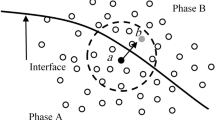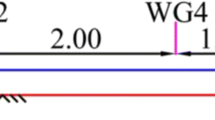Abstract
In this paper, the Weakly Compressible Smoothed Particle Hydrodynamic method was modified to simulate two-dimensional plunging solitary wave breaking process. This model solves the Navier–Stokes equations to obtain both velocity field and density and also solves the equation of state to obtain the pressure field. To simulate the turbulent behavior of fluid flow in a wave breaking procedure, Sub Particle Scale model was used. To correct the Pressure and velocity field in SPH, Riemann Solver was also implemented. This method was modified with a kernel and gradient of kernel correction to overcome the problems associated with the usage of viscous terms in Navier–Stokes equations. The modified kernel gradient was implemented to the model based on modified kernel in Element Free Galerkin Method. To consider the accuracy of the modified model, a dam break test was performed and model results were compared with available experimental data and unmodified models. These comparisons showed good agreement between modified results and the experimental data. Finally, the transform of plunging solitary wave breaking on a slope was simulated using the modified model. The results showed that this model better agrees with the experiments in the plunging jet impact and splash-up processes. Finally, solitary wave impact on a seawall was simulated by the modified model. The results showed that the modified model has good agreement with experimental data.















Similar content being viewed by others
References
Ketabdari MJ, Nobari MRH, Larmaei MM (2008) Simulation of waves group propagation and breaking in coastal zone using a Navier-Stokes solver with an improved VOF free surface treatment. Appl Ocean Res 30(2):130–143
Rezaei H, Ketabdari MJ (2013) Numerical simulation of solitary wave-catamaran breakwater interaction using MFCT model. J Braz Soc Mech Sci Eng 35(4):441–456
Monaghan JJ (2005) Smoothed particle hydrodynamics. Rep Prog Phys 68:1703–1759
Lo EYM, Shao S (2002) Simulation of near-shore solitary wave mechanics by an incompressible SPH method. Appl Ocean Res 24(5):275–286
Mirmohammadi A, Ketabdari MJ (2011) Numerical simulation of wave scouring beneath marine pipeline using Smoothed Particle Hydrodynamics Int. J Sediment Transp 26(2011):331–342
Crespo AJC, Gomez-Gesteira M, Dalrymple RA (2008) Modeling dam break behavior over a wet bed by a SPH technique. J Waterw Port Coast Ocean Eng 134(6):313–320
Monaghan JJ, Kos A (1999) Solitary waves on a Cretan beach. J Waterw Port Coast Ocean Eng 125(3)
Colagrossi A, Landrini M (2003) Numerical simulation of interfacial flows by smoothed particle hydrodynamics. J Comput Phys 191(2):448–475
Ketabdari MJ, Nemati A (2011) Numerical Simulation of Breaking Solitary Wave on the Sloping Beach Using WCSPH Method. Iranian J Marine Tech (in Persian)
Monaghan JJ (1994) Simulating free surface flows with SPH. J Comput Phys 110:399–406
Dalrymple RA, Rogers BD (2006) Numerical Modeling of Water Waves with the SPH Method. Coast Eng 53(2–3):141–147
Monaghan JJ (1997) SPH and Riemann solvers. J Comput Phys 136(2):298–307
Parshikov AN, Medin SA (2002) Smoothed particle hydrodynamics using interparticle contact algorithm. J Comput Phys 180:358–382
Rogers BD, Dalrymple RA, Stansby PK (2010) Simulation of caisson breakwater movement using SPH. J Hydraul Res 48:135–141
Monaghan JJ (1992) Smoothed particle hydrodynamics. Annual Rev Astron Appl 30
Gotoh H, Shibihara T, Hayashi M (2001) Sub-particle-scale model for the MPS method-Lagrangian flow model for hydraulic engineering. Comput Fluid Dyn J 9(4):247–339
Khayyer A, Gotoh H, Shao SD (2008) Corrected incompressible SPH method for accurate water surface tracking in breaking waves. Coast Eng 55(3):236–250
Monaghan JJ, Lattanzio JC (1985) A refined method for astrophysical problems. Astron Astrophys 149
Batchelor GK (1967) Introduction to fluid dynamics. Cambridge Univ. Press, Cambridge
Blin L, Hadjadj A, Vervisch L (2003) Large eddy simulation of turbulent flows in reversing systems. J Turbul 4
Smagorinsky J (1963) General circulation experiments with the primitive equations. Mon Weather Rev 91(3):99–164
Bonet J, Lok T-SL (1999) Variational and momentum preservation aspects of smoothed particle hydrodynamic formulations. Comput Methods Appl Mech 180:97–115
Dilts GA (1999) Moving-Least–Squares-Particle Hydrodynamics––I. Consistency and stability. Int J Numer Meth Eng. 44
Bonet J, Kulasegaram S (2000) Correction and stabilization of smoothed particle hydrodynamics methods with applications in metal forming simulations. Int J Numer Meth Eng 47(6):1189–1214
Belytschko T, Krongauz Y, Dolbow J, Gerlach C (1998) On the completness of meshfree particle methods. Int J Numer Meth Eng 43(5):785–819
Monaghan JJ (1989) On the problem of penetration in particle methods. J Compu Phys 82(1)
Dalrymple RA, Knio O (2001) SPH modeling of water waves. ASCE, San francisco
Crespo AJC, Gómez-Gesteira M, Dalrymple RA (2007) Boundary conditions generated by dynamic particles in SPH methods. CMC-Tech Sci Press 5(3)
Hu CH, Kashiwagi M (2004) A cip method for numerical simulations of violent free surface flows. J Mar Sci Tech 9(4):143–157
Martin JC, Moyce WJ (1952) Part IV. An experimental study of the collapse of liquid columns on a rigid horizontal plane. Philos Trans Royal Soc London Series A, Math Phys Sci 244(882): p 312
Grilli ST, Svendsen IA, Subramanya R (1997) Breaking criterion and characteristics for solitary waves on slopes. J Waterw Port Coast Ocean Eng 123(3):102–112
Li Y Tsunamis: Non-breaking and breaking solitary wave run-up, in Rep. KH-R-60. 2000, W. M. Keck Laboratory of Hydraulics and Water Resources, California Institute of Technology: Pasadena, CA
Li Y, Raichlen F (1998) Breaking criterion and characteristics for solitary waves on slopes-discussion. J Waterw Port Coast Ocean Eng 124(6):329–333
Guizien K, Barthe’lemy E (2002) Accuracy of solitary wave generation by a piston wave maker. J Hydraul Res 40(3):321–331
Li Y, Raichlen F (2003) Energy balance model for breaking solitary wave runup. J Waterw Port Coast Ocean Eng 129(2):47–59
Lachaume C, Biausser B, Grilli ST, Fraunie P, Guignard S (2003) Modeling of breaking and post-breaking waves on slopes by coupling of BEM and VOF methods, in Proc. 13th Offshore and Polar Engineering Conf., ISOPE03. Honolulu, USA, pp 353–359
Hsiao S-C, Lin T-C (2010) Tsunami-like solitary waves impinging and overtopping an impermeable seawall: experiment and RANS modeling. Coast Eng 57:1–18
Author information
Authors and Affiliations
Corresponding author
About this article
Cite this article
Rostami Varnousfaaderani, M., Ketabdari, M.J. Numerical simulation of solitary wave breaking and impact on seawall using a modified turbulence SPH method with Riemann solvers. J Mar Sci Technol 20, 344–356 (2015). https://doi.org/10.1007/s00773-014-0287-9
Received:
Accepted:
Published:
Issue Date:
DOI: https://doi.org/10.1007/s00773-014-0287-9




